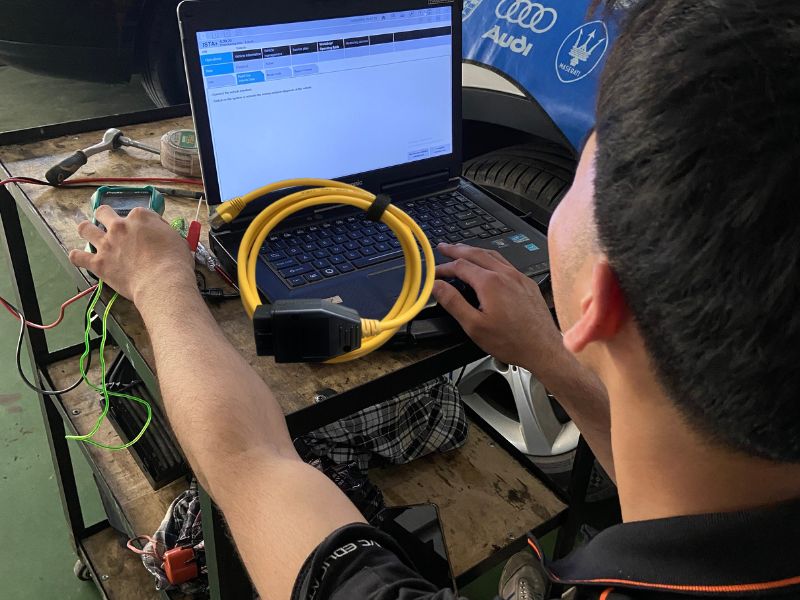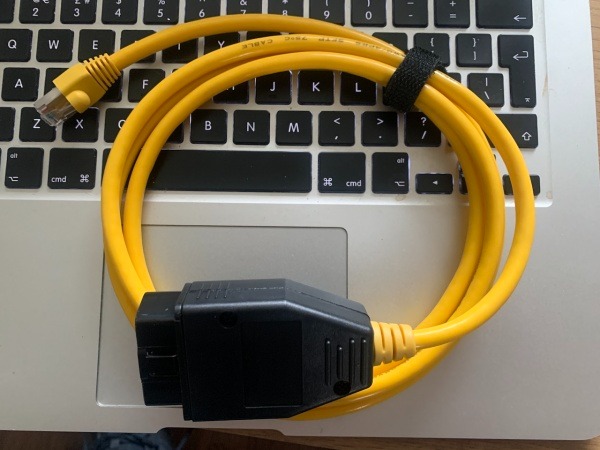Can I use ENET cable for BMW F series coding?
Can I use ENET cable for BMW F series coding? This is a common question among BMW enthusiasts looking to unlock hidden features and customize their vehicles. The answer is yes—ENET cable is a powerful and affordable tool specifically designed for BMW F series coding. With the right software like E-Sys or BimmerCode, users can perform coding tasks such as digital speed displays, auto-folding mirrors, and more. In this article, VCCarTool will guide you through what ENET cable is, how it works with BMW F series, and what you need to get started.

What Is an ENET Cable?
An ENET cable (Ethernet to OBD-II cable) is a specialized diagnostic cable used primarily for BMW F-series vehicles. It connects your vehicle’s OBD-II port to a laptop or mobile device via Ethernet, enabling communication between your BMW and diagnostic or coding software such as E-Sys, BimmerCode, or ISTA+.
Unlike older interfaces like the K+DCan USB cable (for E-series) or expensive diagnostic tools like ICOM, the ENET cable is faster, more affordable, and tailored for the modern F and G series BMWs, which support Ethernet-based communication protocols.

Key Features of the ENET Cable
- High-speed connection using Ethernet protocol (faster than traditional USB-based cables)
- Supports F-series and some G-series BMWs
- Compatible with Windows laptops and mobile apps (via Wi-Fi adapters)
- Works with software like E-Sys for coding, ISTA+ for diagnostics, and BimmerCode/BimmerLink for smartphone-based functions
Use Cases
- Coding hidden features (e.g., video-in-motion, folding mirrors, seatbelt chime off)
- Performing diagnostics and clearing fault codes
- Running service resets and adaptations
If you’re working on a BMW F-series and looking for a cost-effective, fast, and reliable connection method, the ENET cable is one of the best options available today.
Can I Use ENET Cable for BMW F Series Coding?
Yes, you can use an ENET cable to code BMW F-series vehicles. It’s the standard method for models like F10, F30, or F25. This cable offers fast connection speeds and supports tools like E-Sys, BimmerCode, and ISTA+.
However, not all ENET cables are created equal. Low-quality cables may lead to unstable connections, slower diagnostics, or failed coding attempts. In some cases, delays or errors in communication with control units may occur — especially during real-time tasks.
If you plan to use ENET for coding or diagnostics, make sure to choose a reliable, high-quality cable and follow proper setup instructions. At VCCarTool, we provide tested ENET cables and remote support for smooth BMW F-series coding experiences.
What You Can Do with ENET Cable
- Enable hidden features (e.g., digital speedometer, folding mirrors).
- Disable annoying warnings (e.g., seatbelt chimes, legal disclaimers).
- Customize lights, iDrive behavior, sound systems, and more.
- Perform service resets and basic diagnostic scans.
What You Need to Get Started with BMW F Series Coding Using ENET Cable
To begin coding your BMW F-series with an ENET cable, here’s a checklist of the essential tools and software:
High-Quality ENET Cable
- Connects your laptop to the OBD port of your BMW (F-series only).
- Avoid cheap or unbranded versions to prevent unstable connections.
Laptop or PC
Running Windows 10 or 11, with at least 4GB RAM and 100GB free storage.
Coding Software
- E-Sys: Primary tool for coding BMW F-series
- BimmerCode (if using with a smartphone).
- ISTA+ (ISTA-D): For diagnostics and fault code reading/resetting.
BMW Coding Data (PSdZData)
Required by E-Sys for coding modules. Make sure to use a full or lite version depending on your need.
Basic Coding Knowledge or Remote Support
Improper coding may cause issues. If you’re unsure, VCCarTool provides remote coding support and setup guidance.
How ENET Cable Works With BMW F Series
The ENET cable (Ethernet to OBD adapter) is the standard tool for communicating with BMW F series vehicles during coding, diagnostics, and programming. Here’s how it works:
1. Direct Ethernet Communication
The ENET cable connects your BMW’s OBD-II port to your laptop’s Ethernet port. This allows high-speed data transfer between your PC and the vehicle’s control modules using the Ethernet (DoIP) protocol — standard in BMW F series models.
2. Used with E-Sys Software
To access and modify vehicle coding, ENET is paired with E-Sys, BMW’s engineering-level software. You load the correct PSdZData files and select individual modules (ECUs) like FEM, BDC, KOMBI, HU_NBT, etc., for reading or coding.
3. Control Unit Access
ENET provides fast access to key ECUs for:
VO (Vehicle Order) coding
FDL coding (Function-level customization)
Flashing and software updates (limited use; flashing is safer with ICOM)
4. Supports Diagnostics
Although not its primary function, ENET also works with tools like ISTA D for reading and clearing fault codes. However, for complex diagnostics or full programming, BMW ICOM is preferred.
5. No Additional Power Needed
Unlike ICOM or other interfaces, ENET gets power from the OBD port and doesn’t require separate drivers on most Windows systems.
Using an ENET cable for BMW F series coding is a cost-effective and efficient solution for enthusiasts and technicians looking to perform basic coding and diagnostics. It enables fast, direct access to key control modules when paired with the right software like E-Sys or ISTA D. However, users should be aware of its limitations—especially in full programming or ECU flashing—where more advanced tools like ICOM are recommended. For best results, always use a high-quality ENET cable and consider expert support like that from VCCarTool, which provides full software setup and remote guidance to ensure your coding experience is smooth and successful.
Note: While we strive to provide accurate information, occasional errors may occur. For the most reliable support and real-time assistance, please don’t hesitate to contact us via WhatsApp at +1 (901) 414-1927. We’re here to help!
